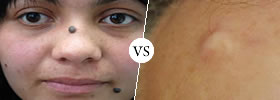Difference Between Silicon and Silicone
Key Difference: Silicon is a metalloid element that is found in the earth’s core. It is found widely in dusts, sands and a part of the planet’s crust. Silicone is a polymer created by mixing silicon with other elements such as carbon, hydrogen and oxygen.
Though silicon and silicone are spelled almost the same way and seem like the same word at first glance, these are two different words that refer to two complete different things. Silicon is naturally found in the Earth, while silicone is an artificially made substance.
![]() Silicon is a metalloid element that is found in the earth’s core. It is found on the periodic table under the symbol Si and the atomic number 14. Silicon is the eight most common element in the universe by mass, but rarely occurs as the pure free element in nature. It was first found in pure form in 1824 and was given the silicium (the ‘ium’ to suggest it is a metal), but it was later changed to Silicon in 1831, when it was discovered to have traits that were more similar to carbon and boron. In its pure form, silicon occurs as grey crystals with a metallic luster.
Silicon is a metalloid element that is found in the earth’s core. It is found on the periodic table under the symbol Si and the atomic number 14. Silicon is the eight most common element in the universe by mass, but rarely occurs as the pure free element in nature. It was first found in pure form in 1824 and was given the silicium (the ‘ium’ to suggest it is a metal), but it was later changed to Silicon in 1831, when it was discovered to have traits that were more similar to carbon and boron. In its pure form, silicon occurs as grey crystals with a metallic luster.
Over 90% of the Earth's crust is composed of silicate minerals, making silicon the second most abundant element in the Earth's crust after oxygen. It is found widely in dusts, sands and a part of the planet’s crust. Silica bonds with oxygen to form silicates such as mica, quartz, jadeite, feldspar, etc. Silicon is solid at room temperature and has relatively high boiling and melting points. Silicon also does not contract when frozen, but rather expands similar to water when turned to ice. Silicon is considered as metalloid as it has both metal and non-metal properties. Silicon can share four electrons to form four covalent bonds. However, it can also accept additional electrons and form additional bonds in some cases.
Due to the high melting and boiling point of silicon, it is commonly used for preparing fireproof products, ceramic glass tiles, glass, bricks, and heat-resistant kitchen aids. Silicon also plays in important part in construction, steel refining, aluminum-casting, and fine chemical industries. It is also acts as a good semi-conductor and is used widely in electrical material and computer processing devices. It is also used to produce solar cells.
![]()
Silicone is a polymer created by mixing silicon with other elements such as carbon, hydrogen and oxygen. The molecular formula of silicone is R2SiO. Silicone can also be known as polymerized siloxanes or polysiloxanes. Depending on the construction and properties, silicone can be found in various different phases including liquid, gel, rubber or hard plastic. Some of the common forms of silicone include silicone oil, silicone grease, silicone rubber, silicone resin and silicone caulk.
Silicones are inert, synthetic compounds that are used in a variety of industries. Properties of silicone include: low thermal conductivity, low chemical reactivity, low toxicity, thermal stability, ability to repel water, sticks to only certain surfaces, does not support microbiological growth, resistant to oxygen, ozone, and ultraviolet (UV) light. These properties of silicone result it in being used in various different processes such as automotive, cookware, coatings, aquarium joints, sealants, defoamers, dry cleaning, electronics, firestops, lubricants, medicines and mouldmaking. Silicones also play a huge part in cosmetic surgery, where it used for breast enhancements. Almost everything in cosmetics such as shampoos, soaps and conditioners all have silicone.
Image Courtesy: robinsonlibrary.com, silicone-bake-ware.co.uk









Comments
V kumar
Fri, 06/09/2017 - 19:13
Add new comment